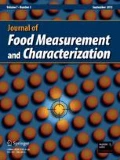Abstract
Temperature is one of the single most important factors influencing accurate refractometer readings and is one of the largest sources of error in measurement. A model based on neural networks, has been implemented to generate solution concentration data, knowing fluid temperature measurements in this solution. The neural network chosen in this study, is the hidden layer feed forward network. Its learning rule is based on the backpropagation of the error. Its training basis consists of concentration measurement, temperature data recorded every time. An in-line process measurement of refractive index (RI) works as a real-time predictive tool for the final concentration in process parameters is proposed. The acquired signal is transmitted, via the Bluetooth, to the processing and diagnostic unit. A predictive modelling using the neural networks enables us to predict its operation under various conditions within a temperature range from 0 up to 40 °C.










Similar content being viewed by others
References
Y. Pomeranz, C.E. Meloan, Refractometry and polarimetry, in Food Analysis, 3rd edn., ed. by Y. Pomeranz, C.E. Meloan (Chapman and Hall, New York, 1994), pp. 430–448
M.A. Karabegov, Automatic differential prism refractometer for monitoring process liquids. Meas. Tech. 50(6), 619–628 (2007)
C.Y. Wu, Y.C. Shih, J.F. Lan, C.C. Hsieh, C.C. Huang, J.H. Lu, Design, optimization, and performance analysis of new photodiode structures for CMOS active-pixel-sensor (APS) imager applications. IEEE Sensors J. 4(1), 135–144 (2004)
V.L. Shur, A.S. Naidenov, A.Ya. Lukin, G.I. Leibengardt, A liquid autocollimation refractometer optophysical measurements. Meas. Tech. 49(8), 815–819 (2006)
C.F. Chan, C. Chen, A. Jafari, A. Laronche, D.J. Thomson, J. Albert, Optical fiber refractometer using narrowband cladding-mode resonance shifts. Appl. Opt. 46, 1142–1149 (2007)
T.N. Soorya, S. Gupta, A. Kumar, S. Jain, V.P. Arora, Temperature dependent optical property studies of nematic mixtures. Indian J. Pure Appl. Phys. 44, 524–531 (2006)
J.W. George, The usefulness and limitations of hand-held refractometers in veterinary laboratory medicine: an historical and technical review. Vet. Clin. Pathol. 30(4), 201–210 (2001)
P. Neelamegam, A. Rajendran, An approach to measure the densities of solids using an artificial neural network. Instrum. Sci. Technol. 35(2), 189–199 (2007)
M. Hagan, H. Demuth, M. Beale, Neural Network Design (PWS Publishing, Boston, 1996)
Y. Su, Y. Sun, Comparing the different arithmetic methods for the offset drift compensation of pressure sensor. Chin. J. Sens. Actuators 17(3), 375–378 (2004)
J.C. Patra, E.L. Ang, N.S. Chaudhari, A. Das, Neural-network based smart sensor framework operating in a harsh environment. J. Appl. Signal Process. 4, 558–574 (2005)
G.B. Huang, Q.Y. Zhu, C.K. Siew, Real-time learning capability of neural networks. IEEE Trans. Neural Netw. 17(4), 863–878 (2006)
A.P. Singh, S. Kumar, T.S. Kamal, Virtual compensator for correcting the disturbing variable effect in transducers. Sens. Actuators A 116, 1–9 (2004)
Y.-L. Lo, C.-H. Chuang, Refractometer based on a path-matching differential interferometer with temperature compensation. Appl. Opt. 40(21), 3518–3524 (2001)
M.F.A. Rasid, B. Woodward, Bluetooth telemedicine processor for multichannel biomedical signal transmission via mobile cellular networks. IEEE Trans. Inf. Technol. Biomed. 9(1), 35–43 (2005)
M. Laghrouche, L. Montes, J. Boussey, S. Ameur, Low-cost embedded spirometer based on micro machined polycrystalline thin film. Flow Meas. Instrum. 22(2), 126–130 (2011)
A.V. Mamaev, M. Saffman, D.Z. Anderson, A.A. Zozuly, Propagation of light beams in anisotropic nonlinear media: from symmetry breaking to spatial turbulence. Phys. Rev. A. 54(1), 870–879 (1996)
Author information
Authors and Affiliations
Corresponding author
Rights and permissions
About this article
Cite this article
Ziani, R., Laghrouche, M. & Mellah, R. Digital embedded refractometer with temperature compensation. Sens. & Instrumen. Food Qual. 5, 72–77 (2011). https://doi.org/10.1007/s11694-011-9113-9
Received:
Accepted:
Published:
Issue Date:
DOI: https://doi.org/10.1007/s11694-011-9113-9




